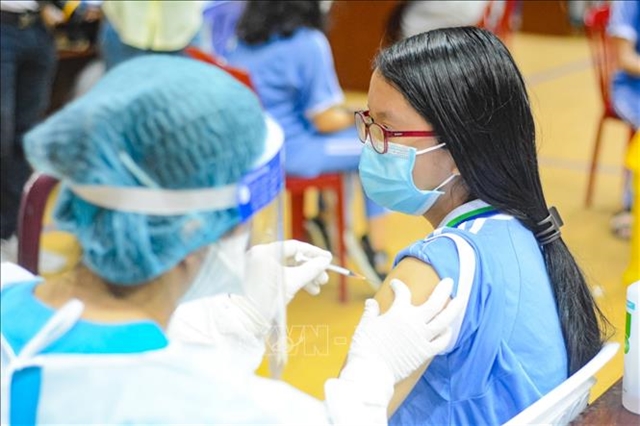
HÀ NỘI — Việt Nam has downgraded COVID-19 from a Class A infectious disease, classified as “especially dangerous”, to Class B according to the Government’s newly-launched COVID-19 prevention and control programme.
In February 2020, the then Prime Minister Nguyễn Xuân Phúc declared COVID-19 to be a Class A infectious disease. COVID-19 was declared a national pandemic in April 2020.
Class A infectious diseases are those with high infection and death rates, like polio, influenza A-H5N1, plague, smallpox, Ebola, Lassa and Marburg hemorrhagic fever, West Nile fever, yellow fever and cholera.
COVID-19 is now regarded as a Class B infectious diseases – dangerous illnesses that can spread fast and cause fatalities – along with HIV/AIDS, rabies, influenza, diphtheria, pertussis, tuberculosis, mumps, dengue fever, malaria, measles, hand-foot-and-mouth disease, tetanus, and rotavirus diarrhoea.
Under the 2022-23 COVID-19 prevention programme issued on Thursday, the Government requested authorities and agencies to strengthen COVID-19 prevention and control, specifically, improve epidemiological surveillance capacity; monitor disease developments; strengthen science and technology applications in monitoring; and analyse and forecast the epidemic situation at central and local levels.
Authorities and agencies are asked to closely monitor the epidemic situation in the world and across the country. They must also promptly amend, supplement and update professional guidelines to ensure compliance with the motto of safe, flexible adaptation and effective control of the pandemic along with economic recovery and development.
The principle of “prevention-detection-isolation-zoning-stamping out” will continue to be applied flexibly, ensuring that the scale and scope will be as narrow as possible, in line with the pandemic’s development.
Việt Nam continues to flexibly apply the formula “5K + vaccine/medicine + treatment + technology + people’s consciousness + other measures”.
The removal of COVID-19 from the Class A list of infectious diseases is a milestone in Việt Nam’s strategy against the disease and serves as a premise for authorities to issue new adaptation policies.
The programme on COVID-19 prevention and control will be implemented from 2022 to 2023. In case the epidemic ends earlier, or lasts until 2024, the Ministry of Health reports to the Government to consider continuing the implementation of the programme or amending it timely to match the situation.
The specific goal of the programme is to ensure coverage of the COVID-19 vaccine. Accordingly, by the end of the first quarter of 2022, Việt Nam will complete the second injection for 12-18 year olds, and the third injection for adults and those with specific vaccination schedules, except for people with vaccine complications.
The country plans to vaccinate children from 5-12 years old by September 2022.
Regarding controlling the spread of COVID, all levels of government have a scenario for COVID-19 prevention and control. All people must comply with the appropriate pandemic prevention and control measures. Agencies, organisations and enterprises carry out the infection risk assessment and update and report the assessment results.
The country expects to have a flexible surveillance and detection strategy for COVID-19 infections, suitable to the pandemic developments in each period. The aim is to reduce the death rate from COVID-19 per million people to a level lower than the Asian average.
Việt Nam will also improve the capacity of the health system, especially preventive medicine and grassroots health, increase investment in equipment and infrastructure for medical facilities, have remuneration policies suitable for those in charge of preventive medicine and grassroots health; enhance the quality of first aid and active resuscitation at medical examination and treatment establishments at all levels.
Access to health services of all vulnerable groups such as the elderly, people with underlying medical conditions, people with disabilities, pregnant women, helpless people, orphans, ethnic minorities, and migrant workers in urban areas are guaranteed.
Việt Nam topped seven million COVID cases in total on Thursday.
After the country entered the fourth wave of the virus in late April 2021, it took just over six months to reach one million transmissions on November 11. By January 15, 2022, it had doubled. By February 24, it hit three million, and by March 13 it hit six million. Just four days later, it recorded more than seven million cases.
The total number of fatalities relating to COVID-19 reached 41,683 on Thursday, accounting for 0.6 per cent of total infections.
The total number of people given the all-clear in the country stood at 3,685,988 on Thursday.
More than 201 million doses of vaccines have been administered in the country to date. — VnExpress News
- Reduce Hair Loss with PURA D’OR Gold Label Shampoo
- Castor Oil Has Made a “Huge” Difference With Hair and Brow Growth
- Excessive hair loss in men: Signs of illness that cannot be subjective
- Dịch Vụ SEO Website ở Los Angeles, CA: đưa trang web doanh nghiệp bạn lên top Google
- Nails Salon Sierra Madre
 VnExpress News The News Gateway of Vietnam
VnExpress News The News Gateway of Vietnam





